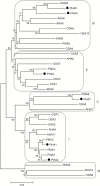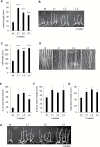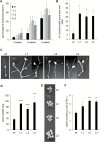The plasma membrane H+-ATPase gene family in Solanum tuberosum L. Role of PHA1 in tuberization
- PMID: 28992210
- PMCID: PMC5853856
- DOI: 10.1093/jxb/erx284
The plasma membrane H+-ATPase gene family in Solanum tuberosum L. Role of PHA1 in tuberization
Abstract
This study presents the characterization of the plasma membrane (PM) H+-ATPases in potato, focusing on their role in stolon and tuber development. Seven PM H+-ATPase genes were identified in the Solanum tuberosum genome, designated PHA1-PHA7. PHA genes show distinct expression patterns in different plant tissues and under different stress treatments. Application of PM H+-ATPase inhibitors arrests stolon growth, promotes tuber induction, and reduces tuber size, indicating that PM H+-ATPases are involved in tuberization, acting at different stages of the process. Transgenic potato plants overexpressing PHA1 were generated (PHA1-OE). At early developmental stages, PHA1-OE stolons elongate faster and show longer epidermal cells than wild-type stolons; this accelerated growth is accompanied by higher cell wall invertase activity, lower starch content, and higher expression of the sucrose-H+ symporter gene StSUT1. PHA1-OE stolons display an increased branching phenotype and develop larger tubers. PHA1-OE plants are taller and also present a highly branched phenotype. These results reveal a prominent role for PHA1 in plant growth and development. Regarding tuberization, PHA1 promotes stolon elongation at early stages, and tuber growth later on. PHA1 is involved in the sucrose-starch metabolism in stolons, possibly providing the driving force for sugar transporters to maintain the apoplastic sucrose transport during elongation.
Keywords: Branching; PHA1; PM H+-ATPase; plant growth; potato; stolon elongation; tuber growth; tuberization.
© The Author 2017. Published by Oxford University Press on behalf of the Society for Experimental Biology.
Figures












Similar articles
-
The protein phosphatase 2A catalytic subunit StPP2Ac2b acts as a positive regulator of tuberization induction in Solanum tuberosum L.Plant Mol Biol. 2017 Feb;93(3):227-245. doi: 10.1007/s11103-016-0555-7. Epub 2016 Nov 3. Plant Mol Biol. 2017. PMID: 27812910
-
StGA2ox1 is induced prior to stolon swelling and controls GA levels during potato tuber development.Plant J. 2007 Oct;52(2):362-73. doi: 10.1111/j.1365-313X.2007.03245.x. Epub 2007 Aug 30. Plant J. 2007. PMID: 17764503
-
Potato CONSTANS is involved in photoperiodic tuberization in a graft-transmissible manner.Plant J. 2012 May;70(4):678-90. doi: 10.1111/j.1365-313X.2012.04909.x. Epub 2012 Mar 5. Plant J. 2012. PMID: 22260207
-
Molecular signals that govern tuber development in potato.Int J Dev Biol. 2020;64(1-2-3):133-140. doi: 10.1387/ijdb.190132ab. Int J Dev Biol. 2020. PMID: 32659001 Review.
-
Auxin: An emerging regulator of tuber and storage root development.Plant Sci. 2021 May;306:110854. doi: 10.1016/j.plantsci.2021.110854. Epub 2021 Feb 18. Plant Sci. 2021. PMID: 33775360 Review.
Cited by
-
Genome-wide identification and analysis of the apple H+-ATPase gene family and its expression against iron deficiency stress.BMC Plant Biol. 2025 Apr 11;25(1):461. doi: 10.1186/s12870-025-06501-1. BMC Plant Biol. 2025. PMID: 40217534 Free PMC article.
-
Exploring regulatory networks in plants: transcription factors of starch metabolism.PeerJ. 2019 Jul 9;7:e6841. doi: 10.7717/peerj.6841. eCollection 2019. PeerJ. 2019. PMID: 31328026 Free PMC article.
-
Regulation of Cytosolic pH: The Contributions of Plant Plasma Membrane H+-ATPases and Multiple Transporters.Int J Mol Sci. 2021 Nov 30;22(23):12998. doi: 10.3390/ijms222312998. Int J Mol Sci. 2021. PMID: 34884802 Free PMC article. Review.
-
Potato tuber degradation is regulated by carbohydrate metabolism: Results of transcriptomic analysis.Plant Direct. 2022 Jan 14;6(1):e379. doi: 10.1002/pld3.379. eCollection 2022 Jan. Plant Direct. 2022. PMID: 35059552 Free PMC article.
-
Identification of the potato (Solanum tuberosum L.) P-type ATPase gene family and investigating the role of PHA2 in response to Pep13.Front Plant Sci. 2024 Jun 6;15:1353024. doi: 10.3389/fpls.2024.1353024. eCollection 2024. Front Plant Sci. 2024. PMID: 38903445 Free PMC article.
References
-
- Ahn S, Im Y, Chung G, Cho B. 1999. Inducible expression of plasma membrane H+-ATPase in the roots of figleaf gourd plants under chilling root temperature. Physiologia Plantarum 106, 35–40.
-
- Albertson PL, Peters KF, Grof CPL. 2001. An improved method for the measurement of cell wall invertase activity in sugarcane tissue. Functional Plant Biology 28, 323–328.
-
- Appeldoorn NJG, de Bruijn SM, Koot-Gronsveld EAM, Visser RGF, Vreugdenhil D, van der Plas L. 1997. Developmental changes involved in conversion of sucrose to hexose-phosphate during early tuberization of potato. Planta 202, 220–226.
-
- Arango M, Gévaudant F, Oufattole M, Boutry M. 2003. The plasma membrane proton pump ATPase: the significance of gene subfamilies. Planta 216, 355–365. - PubMed
-
- Aue HL, Lecomte I, Gendraud M, Petel G. 1999. Change in plasma membrane ATPase activity during dormancy release of vegetative peach-tree buds. Physiologia Plantarum 106, 41–46.
Publication types
MeSH terms
Substances
LinkOut - more resources
Full Text Sources
Other Literature Sources

